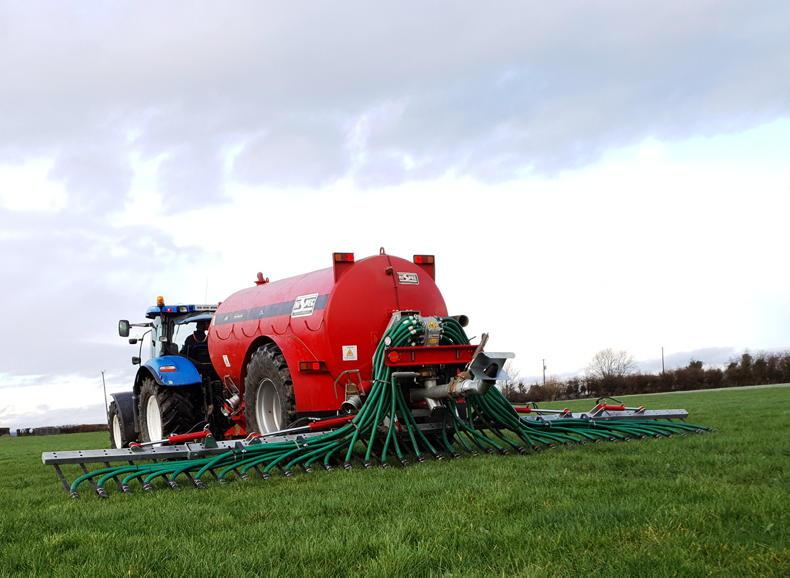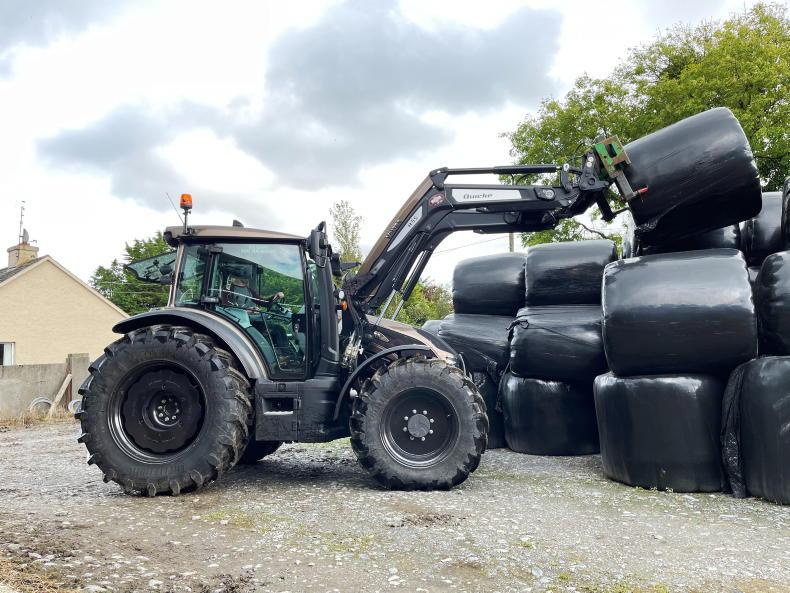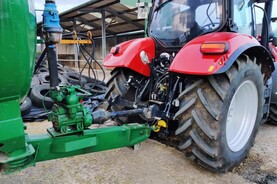Buying in a new tractor is now a significant investment for any farm. Machinery cost inflation has been high over the past five years to the point where new tractor costs are now averaging at €1,000 per unit of tractor horsepower.
That means that the new tractors that accounted for 40% of all new sales in 2022 which are those with a power rating of between 100hp and 140hp, now come with a price tag of more than €120,000.
So why invest in a new tractor at a time of high cost? Modern Irish farming demands the use of powerful, versatile and efficient machines. The tractor of today is vastly different from the tractor of 20 years ago. While some might lament the basic features of previous generation tractors, the reality is that new tractors are more efficient, more versatile and safer than in the past.
Technology
New technology systems, including GPS and auto-steer, now available on modern tractors will allow for greater field efficiency when labour is scarce on the farm. They can also reduce input costs through better fertiliser spreading and spraying accuracy, and for contractors they can deliver more efficient field work through less overlaps and short runs.
Like all machines, tractors too have a lifespan. If we look at the overall pool of agricultural tractors in the country we can see from the most recent Irish Bulletin of Vehicle and Driver Statistics 2021 and 2020 (see Table 1) that there are around 76,500 tractors licensed for use on Irish public roads. That figure is reasonably constant and indicates the actual numbers of working tractors on Irish farms and in Irish agricultural contractor fleets.
The effective working lifespan of a tractor can be argued, but essentially tractors can deliver their optimum performance at reasonable ownership costs up to 15 years in use. Given the number of tractors in Ireland, that equates to a 6% replacement rate, which based on the pool of tractors in the market, would mean a replacement market of 4,500 tractors per year.
That replacement level is what’s happening in the market at present, with over 2,000 new tractors registered in 2022 and an additional 2,600 used tractors imported into Ireland for the first time during that year. The vast bulk of the used tractor imports are now modern tractors that are less than 10 years old, while older tractors are falling off the registration panel. This means that the pool of tractors has remained constant and that we are replacing tractors in Ireland on the basis of 6% or about every 15/16 years (see Table 2), which is a reasonable expectation of what we need to do for a modern farming industry.
For each individual farm or contractor operation, the more difficult decision is often which size tractor to buy to meet the power and working demands of the farm. You need to think through the work that the tractor is expected to do and add in the flexibility in terms of power, for the farm’s future needs over the 15-year lifespan of the tractor.
Running costs
That choice is important because tractor running costs have become significant. Depending on the use level, the ownership costs will be dominated by depreciation and fuel costs, while in a contractor operation the labour costs will also be significant and need to be included.

The additional machinery investment fuelled by TAMS and LESS grant aid can add to tractor and machinery costs on farms.
For farm enterprises, tractor use will rarely be over 1,000 hours of annual work. Many farms will have lower use levels and this will continue as investment in materials handlers such as compact loader and telescopic loaders can make more sense than tractors in some cases. Typical depreciation costs vary from €10 to €15 per engine hour of use. These figures (see Table 3) are based on trade-in values coupled with the cost to change a tractor that machinery dealers will quote, depending on the condition of the tractor being traded and the brand chosen.
With a use level of 1,000 hours that’s an annual depreciation cost of close to €15,000. The only way to manage depreciation in a positive way is to keep maintenance/servicing up to date and lower use levels and that might, depending on the brand and the specific model, lower the depreciation rate from €15,000 to €10,000 per year.
Investment
It is important also to remember that the additional machinery investment fuelled by TAMS and LESS grant aid can add to tractor and machinery costs on farms. The Teagasc Farm Management Survey 2021 showed that 57% of investment on dairy farms related to machinery investment, which was over 50% higher than in 2020. The Teagasc figures show that machinery depreciation costs in 2021 were also up 25% over 2020 figures. Machinery operating costs also increased on average by 14% between 2020 and 2021.
This is all part of the unintended consequences of investing in new machinery that also demands changing a tractor. A good example is the arrival of a trailing shoe slurry spreader that may demand a bigger and more powerful tractor on the farm for reasons of engine and hydraulic power and also safety and stability.
The Teagasc figures show that on tillage farms machinery depreciation costs increased by 53% between 2020 and 2021, while machinery operating costs increased by 40%. This came at a time when contractor costs increased by between 3% and 5%, according to the Teagasc data. This has happened at a time when ploughing is being replaced by minimum cultivations systems that can be more power hungry in terms of tractor capacity.
That’s why it is important to be cautious about investing in a new tractor at a time of high cost inflation.
When farm incomes come under pressure, there is an urgent need to examine costs. Machinery costs are now significant on many farms, so making the decision to buy a new tractor demands careful consideration.
You also need to carefully examine the wider benefits of upgrading your tractor which may be operational, for safety reasons and of course there are taxation implications, including capital allowances opportunities. These can outweigh the extra operational costs depending on the individual farm circumstances.
Interest rates have increased marginally, but even at today’s marginally higher rates, these will not be a deterrent to tractor investment.
The more important considerations when buying a new tractor revolve around any changes to the ownership and operational costs weighed up against the improved timeliness and accuracy. Examine your cost to change numbers and weigh up fuel costs. Then decide if your farm can carry these extra costs. After that it’s up to you to make sure that the new tractor delivers the benefits for your farm.
Buying in a new tractor is now a significant investment for any farm. Machinery cost inflation has been high over the past five years to the point where new tractor costs are now averaging at €1,000 per unit of tractor horsepower.
That means that the new tractors that accounted for 40% of all new sales in 2022 which are those with a power rating of between 100hp and 140hp, now come with a price tag of more than €120,000.
So why invest in a new tractor at a time of high cost? Modern Irish farming demands the use of powerful, versatile and efficient machines. The tractor of today is vastly different from the tractor of 20 years ago. While some might lament the basic features of previous generation tractors, the reality is that new tractors are more efficient, more versatile and safer than in the past.
Technology
New technology systems, including GPS and auto-steer, now available on modern tractors will allow for greater field efficiency when labour is scarce on the farm. They can also reduce input costs through better fertiliser spreading and spraying accuracy, and for contractors they can deliver more efficient field work through less overlaps and short runs.
Like all machines, tractors too have a lifespan. If we look at the overall pool of agricultural tractors in the country we can see from the most recent Irish Bulletin of Vehicle and Driver Statistics 2021 and 2020 (see Table 1) that there are around 76,500 tractors licensed for use on Irish public roads. That figure is reasonably constant and indicates the actual numbers of working tractors on Irish farms and in Irish agricultural contractor fleets.
The effective working lifespan of a tractor can be argued, but essentially tractors can deliver their optimum performance at reasonable ownership costs up to 15 years in use. Given the number of tractors in Ireland, that equates to a 6% replacement rate, which based on the pool of tractors in the market, would mean a replacement market of 4,500 tractors per year.
That replacement level is what’s happening in the market at present, with over 2,000 new tractors registered in 2022 and an additional 2,600 used tractors imported into Ireland for the first time during that year. The vast bulk of the used tractor imports are now modern tractors that are less than 10 years old, while older tractors are falling off the registration panel. This means that the pool of tractors has remained constant and that we are replacing tractors in Ireland on the basis of 6% or about every 15/16 years (see Table 2), which is a reasonable expectation of what we need to do for a modern farming industry.
For each individual farm or contractor operation, the more difficult decision is often which size tractor to buy to meet the power and working demands of the farm. You need to think through the work that the tractor is expected to do and add in the flexibility in terms of power, for the farm’s future needs over the 15-year lifespan of the tractor.
Running costs
That choice is important because tractor running costs have become significant. Depending on the use level, the ownership costs will be dominated by depreciation and fuel costs, while in a contractor operation the labour costs will also be significant and need to be included.

The additional machinery investment fuelled by TAMS and LESS grant aid can add to tractor and machinery costs on farms.
For farm enterprises, tractor use will rarely be over 1,000 hours of annual work. Many farms will have lower use levels and this will continue as investment in materials handlers such as compact loader and telescopic loaders can make more sense than tractors in some cases. Typical depreciation costs vary from €10 to €15 per engine hour of use. These figures (see Table 3) are based on trade-in values coupled with the cost to change a tractor that machinery dealers will quote, depending on the condition of the tractor being traded and the brand chosen.
With a use level of 1,000 hours that’s an annual depreciation cost of close to €15,000. The only way to manage depreciation in a positive way is to keep maintenance/servicing up to date and lower use levels and that might, depending on the brand and the specific model, lower the depreciation rate from €15,000 to €10,000 per year.
Investment
It is important also to remember that the additional machinery investment fuelled by TAMS and LESS grant aid can add to tractor and machinery costs on farms. The Teagasc Farm Management Survey 2021 showed that 57% of investment on dairy farms related to machinery investment, which was over 50% higher than in 2020. The Teagasc figures show that machinery depreciation costs in 2021 were also up 25% over 2020 figures. Machinery operating costs also increased on average by 14% between 2020 and 2021.
This is all part of the unintended consequences of investing in new machinery that also demands changing a tractor. A good example is the arrival of a trailing shoe slurry spreader that may demand a bigger and more powerful tractor on the farm for reasons of engine and hydraulic power and also safety and stability.
The Teagasc figures show that on tillage farms machinery depreciation costs increased by 53% between 2020 and 2021, while machinery operating costs increased by 40%. This came at a time when contractor costs increased by between 3% and 5%, according to the Teagasc data. This has happened at a time when ploughing is being replaced by minimum cultivations systems that can be more power hungry in terms of tractor capacity.
That’s why it is important to be cautious about investing in a new tractor at a time of high cost inflation.
When farm incomes come under pressure, there is an urgent need to examine costs. Machinery costs are now significant on many farms, so making the decision to buy a new tractor demands careful consideration.
You also need to carefully examine the wider benefits of upgrading your tractor which may be operational, for safety reasons and of course there are taxation implications, including capital allowances opportunities. These can outweigh the extra operational costs depending on the individual farm circumstances.
Interest rates have increased marginally, but even at today’s marginally higher rates, these will not be a deterrent to tractor investment.
The more important considerations when buying a new tractor revolve around any changes to the ownership and operational costs weighed up against the improved timeliness and accuracy. Examine your cost to change numbers and weigh up fuel costs. Then decide if your farm can carry these extra costs. After that it’s up to you to make sure that the new tractor delivers the benefits for your farm.







 This is a subscriber-only article
This is a subscriber-only article









SHARING OPTIONS: